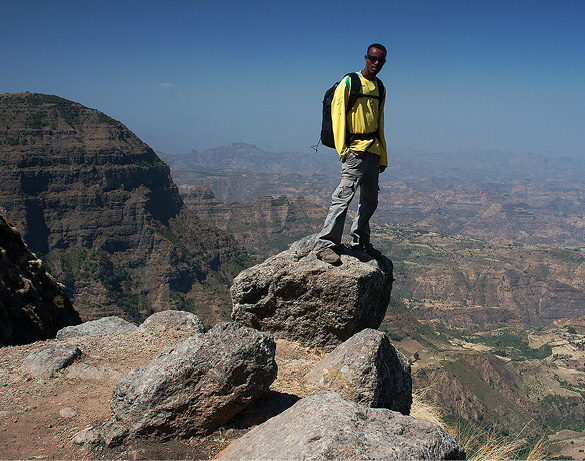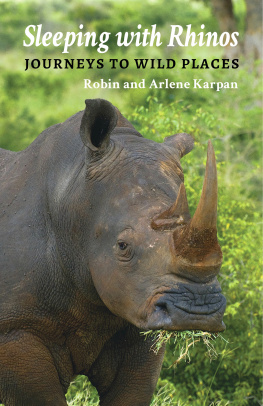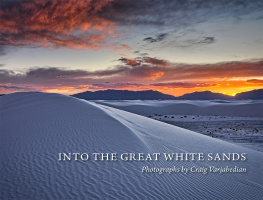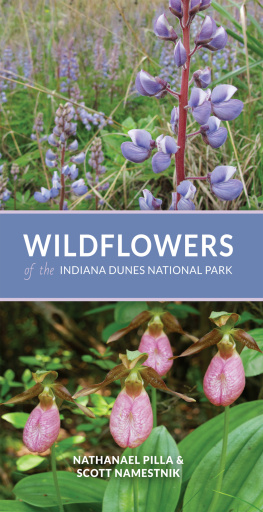Sleeping with Rhinos
JOURNEYS TO WILD PLACES
Robin and Arlene Karpan
Saskatoon
Copyright 2013 by Robin and Arlene Karpan
All rights reserved. No part of this book may be reproduced or used in any form by any meansgraphic, electronic, mechanical, including photocopying, recording, taping, or any information storage and retrieval systemwithout permission in writing from the publisher, except by a reviewer who may quote brief passages of text in a review.
All photographs Copyright Robin and Arlene Karpan
Published in Canada in 2013 by
Parkland Publishing
501 Mount Allison Place
Saskatoon, Saskatchewan
Canada S7H 4A9
Telephone: 306-242-7731
info@parklandpublishing.com
www.parklandpublishing.com
Printed in Canada by Houghton Boston, Saskatoon.
EPUB ISBN:978-0-9809419-5-1
mobi ISBN:978-0-9809419-6-8
E-book conversion by Human Powered Design
Parkland Publishing acknowledges the support of the Creative Industry Growth and Sustainability program made possible through funding provided to the Saskatchewan Arts Board by the Government of Saskatchewan through the Ministry of Tourism, Parks, Culture, and Sport.
Library and Archives Canada Cataloguing in Publication
Karpan, Robin, author
Sleeping with rhinos: journeys to wild places / Robin and Arlene Karpan
ISBN 978-0-9809419-4-4 (pbk.)
1. Karpan, Robin--Travel. 2. Karpan, Arlene--Travel.
3. Adventure travel. 4. Voyages around the world.
I. Karpan, Arlene, author II. Title
G439.K36 2013 910.41 C2013-905639-4
Front cover: White rhinoceros, South Africa.
Contents
Ethiopias Simien Mountains
Close Encounters with Africas Big Five
Languid Lions and Leaping Leopards
Ramblings through Southern Namibia
Saskatchewans Athabasca Sand Dunes
Igloo Homestay on the Arctic Tundra
Harp Seals in the Gulf of St. Lawrence
Unravelling the Mysteries of Easter Island
Back on the Rails in the Copper Canyon
The Great Monarch Migration
Glaciers, Guanacos, and Gales Galore
Exploring the Antarctic Peninsula
Introduction
This book originated from the sheer joy of travel. We have wandered around some exciting parts of the globe over the years, both in our work as travel writers and photographers, and as ordinary travellers simply curious to see what lies over the next hill. As much as we've enjoyed the attractions of great cities and great civilizations, what has stayed with us the most are the wonders of nature breathtaking landscapes, unspoiled wilderness, fascinating wildlife. The more we travel these days, the more we're drawn to those exceptional places. Unfortunately, these parts of the world are disappearing the fastest.
The world continues to change, as it always has, although today we seem to be living in an era of unprecedented transformation, both good and bad. When it comes to the natural world, the news tends to be more bad than good population pressures, global warming, deforestation, more species becoming extinct. A month before publication, news reports raised concerns that after an unusually low migration of monarch butterflies to Mexico, parts of Canada that usually have plenty of returning monarchs have none at all. Only time will tell if this is a temporary glitch or something more serious. There is less question about the seriousness of the rhino poaching problem in South Africa, or the impact of global warming on the Arctic. UNESCO may revoke World Heritage Site status from Ethiopia's Simien Mountains if human impact continues to be a problem. Closer to home, we've watched dramatic changes over a couple of decades as loggers, miners, and road builders penetrate deeper into pristine boreal forest, lakelands, and river valleys of the northern Saskatchewan wilderness.
While there is much to lament, this collection of stories celebrates the joys of discovering nature's wonders the thrill of getting close to Africa's great predators, watching the sun rise from atop a giant sand dune in the Namibian desert, gazing over the stark beauty of Antarctica, rambling through the wilds of Patagonia. If the world's special places and special creatures are to survive, it will be because people know about them and care about them.
These stories span several years, and range from the Arctic to Antarctic, Africa to Latin America, to a tiny spec in the middle of the Pacific Ocean. Above all, Sleeping with Rhinos is an escape from our increasingly over-crowded, over-urbanized, and over-civilized world to places where wildness is valued and Mother Nature still has some clout.
Trekking on the Roof of Africa
Ethiopias Simien Mountains

Trekking guide Getachew in the Simien Mountains.
Our lungs gasp for air with each upward step. The air thins as our path tops altitudes over 4,000 metres, but jaw-dropping views more than make up for the discomfort. Standing on the edge of the escarpment, we gaze in awe over soaring jagged peaks, stone columns, and gorges dropping into oblivion. Not only does this dramatic land hold some of the most impressive landscapes anywhere, its home to plants and animals found nowhere else on Earth.
The Simien Mountains of northern Ethiopia are known as the Roof of Africa. While a few other African peaks are higher, Mount Kilimanjaro being the most famous, they are mostly individual mountains. The Simiens are part of a vast mountain plateau with several peaks topping 4,000 metres; Ras Dashen is the highest, at 4,543 metres. This combination of outstanding scenery and habitat for rare species earned the Simien Mountains UNESCO World Heritage Site status. Indeed, it was among the original 12 places in the world so named in 1978 when the United Nations first started designating sites of outstanding cultural or natural significance.
We start our journey with a one-hour flight from the Ethiopian capital of Addis Ababa to the northern city of Gonder, a former ancient capital dominated by a 17th century castle, also a World Heritage Site. Dubbed the Camelot of Africa, the fairly-tale castle built by Emperor Fasil is part of a rambling walled Royal Enclosure filled with palaces, churches, banquet halls, and even a cage that held lions.
Gonder brims with history at every turn. We wander through the ornate Debre Birhan Selasie Church, dating to 1690, where colourful Biblical scenes cover every inch of the interior. The life of Christ is portrayed, St. George is slaying the dragon, and a fearsome painting of the Devil surrounded by flames reminds the faithful not to stray. The ceiling is adorned with the faces of 80 winged cherubs, each with a different expression.
Christianity was embraced in Ethiopia even before Europe. The enduring history and traditions of the Ethiopian Orthodox Church continue to pervade the life of the country. The day we arrive, crowds are gathering in the streets outside our hotel. A funeral procession is underway for a high ranking priest, with chanting and ceremony at several stops along the slow route to the church. The funeral is somber but certainly not drab. Many wear robes of pure white, while some priests and attendants are dressed to the hilt in a rainbow of colours, carrying umbrellas in dazzling shades of red and gold.













